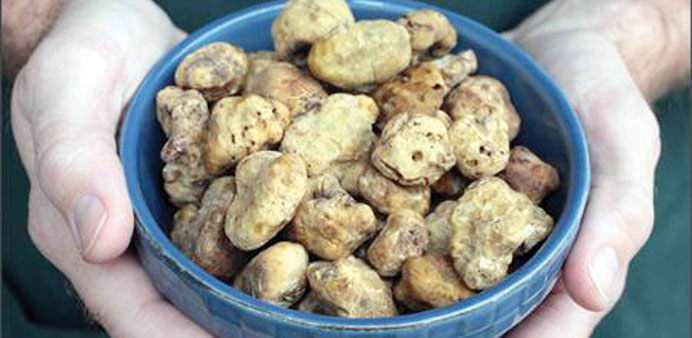By Steff Gaulter
If you’d have asked me a few years ago, I’d have told you I didn’t like truffles. Not the chocolate kind, I’ve always liked those, but the pungent fungi that grow underground; I’d always found their flavour completely overpowering.
However, that all changed when I ended up in a fabulous hidden restaurant in Lisbon. The set menu included a pasta dish with a creamy truffle sauce and I can honestly say it was one of the most delicious things I’ve ever eaten.
From that moment on my eyes were opened. I found truffle oil in Doha, and have tried it on most types of food now, with varying amounts of success if I’m honest.
A few weeks ago my friend told me that he’d seen people searching for truffles in Qatar. At first I was incredulous, how can the delicacy of European cuisine be found in Qatar’s desert? However it turns out to be true; truffles can be found in Qatar, and exactly how many grow is highly dependent on the weather.
In fact it turns out that truffles can be found in many different parts of the globe. They come in two different colours: white or black. The black truffle is generally smaller than its white counterpart, but is more common.
White truffles are typically only found in northern Italy and Croatia, but black truffles have been discovered in France, Spain, Serbia, Tasmania and Western Australia. A slightly different variety of truffle has also been found in the USA, and in Qatar it’s the “desert truffle” which grows. This delicacy has also been discovered in North Africa and the Middle East.
Wherever they are found, truffles are highly sought after, and therefore they can be incredibly expensive. The record price paid for a single white truffle, was $330,000 in 2007 by the owner of a casino in Macau. He’s clearly a man who loves his food!
Now you’ve discovered how expensive they are, you’re probably eagerly waiting to see exactly where you can find them! The first thing to realise is that they can’t grow on their own.
A truffle is the fruiting body of a fungal colony, but the fungus cannot produce its own nutrients. They are what’s known as mycorrhizal, which means that they grow in association with the roots of another plant, stealing the carbohydrates and nutrients that they need from that other plant.
Often the other plant is a tree. In Europe this could be one of many different species including a birch, oak or hazel. In the United States, they can sometimes be found growing with pecan trees. In Qatar, the favoured plant is the desert sunflower. This is a plant that grows up to a metre high and as its name suggests, has bright yellow flowers. The centre of the flowers is generally orange, rather than the dark brown centres of traditional sunflowers.
Even when you know which plant to search near, truffles still aren’t very easy to find.
In Europe, historically pigs were used to root out the fungi. Female pigs have a natural truffle seeking ability, as there is a compound within the truffle which is similar to the pheromone of boar saliva. Unfortunately, the downside is that having found the delicacy, the pig generally gobbles it up! This has led to pigs slowly being replaced by dogs. Man’s best friend needs training in order to root out the fungus, but once trained at least it doesn’t devour the treasure.
However, it is possible to find truffles without the aid of a four-legged companion. If you find a desert sunflower, then try looking about 1m from the plant, and 5 or 10cm below the surface.
Sometimes if you search for them very early in the morning or at sunset you might see a small shadow from a slightly raised area of sand above the growing truffle.
The main reason that truffles are so expensive is because they’re almost impossible to cultivate on a commercial scale. Even with perfect soil conditions, you are completely at the mercy of the weather.
Truffles don’t like the extremes of temperature, or extremes of moisture. The soil must be well-drained, but it can’t be bone dry. This is where Qatar has trouble; there must be sufficient rainfall, which we don’t have every year.
To initiate the germination process, there must be a significant amount of rain in October and November. This is the time that the truffle spores start to grow and colonise the roots of the desert sunflower.
After germination, the rain needs to stop, because otherwise there is the risk that the fungi will rot. Therefore, if we’re hoping for a bumper crop, we should hope for plenty of rain in the autumn, but then a dry spell throughout December and January.
In February and March, a light shower or two is needed to allow the truffles to form. Researchers have found out that 200mm (8 inches) of rain is the perfect amount to produce a decent harvest.
This is a problem for Qatar, because in Doha there is only an average of 75mm (3 inches) of rainfall in the year. However, it’s worth remembering that more rain falls in the north of Qatar.
Also, even without 200mm of rain, there is still the chance of finding truffles by looking in hollows and other places that may dry out more slowly. There, the truffles will be smaller, but just as tasty!
As the temperatures have started to soar, the season for truffle hunting in Qatar is now over, but this next winter, let’s hope for generous rainfall in October, November, February and March.
This should then produce a generous number of truffles for us to hunt; once you find one make sure you head home as quickly as possible. Truffles don’t like sun or humidity, and after having spent so much time finding them, it would be tragic if all your efforts went to waste.

